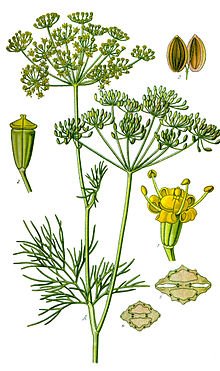Dill

Dill (Anethum graveolens) is an annual herb in the celery family Apiaceae. It is the only species in the genus Anethum. Dill is grown widely in Eurasia, where its leaves and seeds are used as a herb or spice for flavouring food.
Dill grows up to 40–60 cm (16–24 in), with slender hollow stems and alternate, finely divided, softly delicate leaves 10–20 cm (4–8 in) long. The ultimate leaf divisions are 1–2 mm (1⁄32–3⁄32 in) broad, slightly broader than the similar leaves of fennel, which are threadlike, less than 1 mm (1⁄16 in) broad, but harder in texture. The flowers are white to yellow, in small umbels 2–9 cm (1–3 1⁄2 in) diameter. The seeds are 4–5 mm (3⁄16–3⁄16 in) long and 1 mm (0.04 in) thick, and straight to slightly curved with a longitudinally ridged surface.[citation needed]
The word dill and its close relatives are found in most of the Germanic languages; its ultimate origin is unknown.[3] The generic name Anethum is the Latin form of Greek ἄνῑσον / ἄνησον / ἄνηθον / ἄνητον, which meant both ‘dill’ and ‘anise’. The form anīsum came to be used for anise, and anēthum for dill. The Latin word is the origin of dill’s names in the Western Romance languages (anet, aneldo, etc.), and also of the obsolete English anet.[4] Most Slavic language names come from Proto-Slavic *koprъ,[5] which developed from the PIE root *ku̯ə1po- ‘aroma, odor’.[6]
